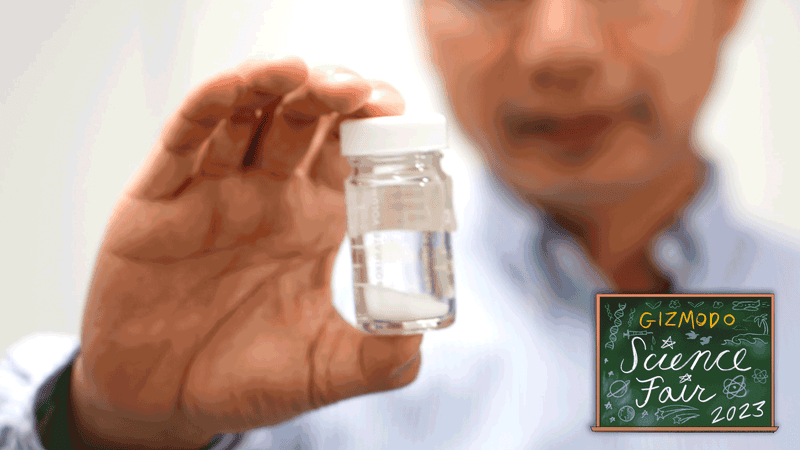Just How White Can White Paint Get?

Professor Xiulin Ruan with the boron nitride white paint.
It’s common sense: When it’s hot outside, don’t put on a dark shirt—wear white instead. A team of researchers at Purdue University has put this common knowledge to work to figure out ways to cool buildings, planes, and even cars with the world’s whitest paints.
The concept of using white paint to deflect heat isn’t new. As far back as the 1970s, scientists and manufacturers had been developing whiter and whiter paints to help reflect sunlight and keep buildings and other surfaces cool. However, the whitest paints available on the market today reflect 90% of light—a number that sounds high but means they still absorb 10% of sunlight and so cannot cool a surface below the ambient temperature.
Read more
These Winning Close-Up Photos Show Life That's Often Overlooked
Remembering Enterprise: The Test Shuttle That Never Flew to Space
In 2014, a group from Stanford wrote a paper on using layers of reflective surfaces of inorganic compounds to reflect sunlight and cool surfaces below the ambient temperature during the day, a process that, while effective, was expensive and not scalable. Purdue University engineering professor Xiulin Ruan, inspired by the Stanford work, started to wonder about the further practical applications of nanotechnology in working with paints, specifically to combat climate change.
“We were not really thinking about developing the whitest paint,” Ruan said. “My background is as a civil engineer and researcher, so I care about that heat. I started to wonder, can we have the scalable nanotechnology... so can we revisit paints to make [cooling] work?”
Ruan and his team, winners of the 2023 Gizmodo Science Fair, started by attempting to optimize a preexisting commercial paint that used titanium dioxide, but they realized that titanium dioxide absorbs UV light. “That fundamentally limits the performance,” Ruan said. His team began experimenting with different formulations of white paint involving different compounds that don’t absorb UV light, playing with particle size and concentration of particles to achieve higher and higher reflectiveness.
“We spent many years doing formulations and simulations, and it took many postdocs and PhD students to figure out the tricks,” Ruan said. “We really had to combine all the factors and push them into extremes to achieve this extreme performance.”
Eventually, Ruan’s team came up with a paint that used high concentrations of barium sulfate particles of varying sizes, which was able to reflect 95% of sunlight. It was so effective that they quickly outpaced their own record, and in 2021 created a paint that reflects 98.1% of sunlight. It’s currently the whitest paint on the planet.
After the 2021 success, Ruan began to get inquiries from people in industries like aerospace and aviation, who were interested in how the paint could be used to cool their products. “They asked us two questions: can you make this thinner, and can you make this lighter?” he said.
The barium sulfate paint, while extremely reflective, requires a coat at least 0.4 millimeters thick to be effective—a nonstarter in industries that seek to make their products as light as possible. The paint was also not very viscous: The barium sulfate paint was formulated as a gel for maximum effectiveness, which makes it difficult to apply to surfaces that are not buildings or structures.
“It’s not easy to make paint paintable, sprayable, or brushable,” said Ruan.
He tapped his Purdue colleague George Chiu, who has a background in photonics and digital printing, as well as two PhD students, Andrea Felicelli and Ioanna Katsamba, to figure out a way to keep the light-reflecting properties of barium sulfate without the extra baggage the compound adds.

“Barium sulfate has reflective properties that allow us to hold below ambient temperature,” said Felicelli, whose research focuses on bioinspired nanocomposites. “But it also contributes a lot to the weight of the paint.”
They began looking at different materials to use in a new formulation of the paint. They eventually settled on hexagonal boron nitride, an inorganic compound mostly used in lubricants. Not a lot of literature had been written around how particle shape helps reflect sunlight, and Katsamba was tasked with modeling how boron nitride helped make the paint reflective—a topic that hadn’t really been addressed before. Boron nitride has a unique morphology, called nanoplatelets, that proved to help it repel sunlight more effectively than spherical particles in other compounds.
“The simulations show that it’s not only the properties of boron nitride, which are different from barium sulfate, but also the shape that really helps on achieving that higher reflectivity we have now,” Katsamba said.
Even after settling on a compound that models showed would be great at reflecting sunlight, making the paint itself was still a challenge—especially given that boron nitride’s morphology made some of the paints thicker and less viscous.
“We definitely had some issues getting the particles to incorporate fully into the paint mixture,” Felicelli said. “But over time, we were able to resolve those different processing techniques. And we were able to achieve an application that was very similar to your regular commercial white paint.”
The resulting paint using boron nitride is nearly as effective as the first formulation with barium sulfate: It can reflect up to 97.9% of sunlight. What’s more, it only requires a 0.15 millimeter layer to be effective, and, thanks to the compound’s porous structure that incorporates a lot of air, weighs 80% less than the barium sulfate paint.
While you can’t go out and buy this ultra-white paint right now, Ruan said the team is in talks with manufacturers to begin the process of creating and selling it as a product. The paint is also being perfected and tested to ensure it can resist dirt and can last as long under UV light as commercial white paints. Down the road, Ruan said, he’s also interested in creating reflective paint in different colors, as well as paints that could switch from reflective to absorptive, depending on the season—like a building-size version of drinkware that changes color when you pour hot or cold water into it.
“Right now, the paint is for cooling, so it’s great for hot climates,” he said. “But in Indiana, for example, we need heat in the winter. It would be great if you were able to switch from the whitest paint in the summer to a color that can absorb sunlight. That is challenging to make it cost effective, to make it scalable. We are investigating, and we can’t expose all the details now, but we can learn from nature to help us understand how to make those kinds of technologies possible.”
Read more: The World’s Whitest Paint Is Literally the Coolest
More from Gizmodo
Sign up for Gizmodo's Newsletter. For the latest news, Facebook, Twitter and Instagram.

